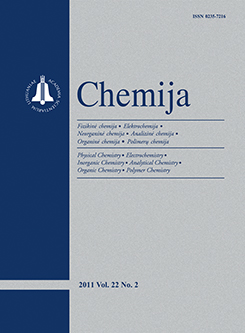 ISSN 0235-7216 ISSN 2424-4538 (online) |
2010 m. Nr. 1 Thallium sulfides and their layers on polyamide surface
When polyamide 6 (PA) films are exposed for different time to acidified solutions of sodium trithionate, Na2S3O6, and sodium tetrathionate, Na2S4O6, and later to alkalified solution of Tl2SO4, TlxS layers on PA films are formed. A study of IR and UV absorption spectra has shown that pentathionate, S5O62–, ions are sorbed from acidified water solutions of potassium pentathionate, K2S5O6, by PA films. The concentration of pentathionate ions sorbed into a polymer increases with increasing the concentration of K2S5O6 solution, as well as the temperature and duration of treatment. A layer of nonstoichiometric thallium sulfide, TlxS, was obtained after treating sulfurized PA with a solution of Tl2SO4. The concentration of thallium increased when the concentration and temperature of the pentathionate solution had been increased. Supposedly, a compact TlxS layer forms on the PA film, which terminates the further diffusion of Tl+ ions from Tl(I) salt solution. The water solution of dodecathionic acid, H2S12O6, acts effectively as a sulfurization agent of PA. The values of sulfur concentration in PA increase with increasing the duration of treatment and the temperature of H2S12O6 solution. TlxS layers are formed on the surface of PA film if a polymer sulfurized in H2S12O6 solution is treated with alkalified solution of Tl2SO4. The concentration of thallium in the polyamide film increases with increasing the duration and temperature of initial sulfurization. Four thallium sulfide phases, TlS, Tl2S2, Tl4S3 and Tl2S5, were identified in the composition of the layers by X-ray diffraction. The determined regularities enable formation by the sorption–diffusion method of thallium sulfide layers of a desirable composition, using dodecathionic acid as a PA sulfurization agent. The XPS analysis of TlxS layers, formed by using H2S12O6 solution as a precursor, showed various thallium, sulfur and oxygen compounds: Tl2O3, Tl2S3, Tl2S, S8, Tl2SO4 and Tl(OH)3. Studies of TlxS layer surface morphology by the AFM method have shown that, depending on the temperature of the initial polyamide sulfurization in K2S5O6 or H2S12O6 solution (in the same “thalliumizing” conditions of sulfurized PA), thallium sulfide layers are formed unevenly as islands which grow into bigger agglomerates. The surface of the coatings is rather uneven and rough. Keywords: review, polythionates, polyamide, thallium sulfide layer |
Issues:
2017 - Vol.28 No. 1, No. 2, No. 3, No. 4 2016 - Vol.27 No. 1, No. 2, No. 3, No. 4 2015 - Vol.26 No. 1, No. 2, No. 3, No. 4 2014 - Vol.25 No. 1, No. 2, No. 3, No. 4 2013 - Vol.24 No. 1, No. 2, No. 3, No. 4 2012 - Vol.23 No. 1, No. 2, No. 3, No. 4 2011 - Vol.22 No. 1, No. 2, No. 3, No. 4 2010 - Vol.21 No. 1, No. 2-4 2009 - Vol.20 No. 1, No. 2, No. 3, No. 4 2008 - Vol.19 No. 1, No. 2, No. 3-4 2007 - Vol.18 No. 1, No. 2, No. 3, No. 4 2006 - Vol.17 No. 1, No. 2-3, No. 4 2005 - Vol.16 No. 1, No. 2, No. 3-4 2004 - Vol.15 No. 1, No. 2, No. 3, No. 4 2003 - Vol.14 No. 1, No. 2, No. 3, No. 4 2002 - Vol.13 No. 1, No. 2, No. 3, No. 4 2001 - Vol.12 No. 1, No. 2, No. 3, No. 4 |